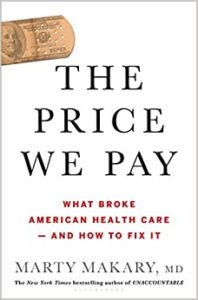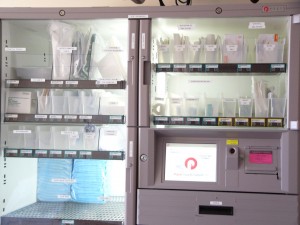How an increase in medical doctors had the paradoxical effect of making medical care much more expensive
Since the late 1960s, there has been an underlying tension between society’s need to control medical expenditures and a medical care system that is geared toward perpetual expansion. This translated into more hospitalizations, diagnostic procedures, more medical treatment, more surgery, more return visits. The obvious result of this avalanche of “more” is a dramatic increase in the amount of money that people, employers, insurance carriers and governments spent on so-called “health care”, which in actually fact is “sickness care“.
Before the mid-1960s, there were not enough doctors to meet the needs of the population, so the over use of health services or over treatment of medical conditions were not an issue.
 That all changed with passage of the Health Professions Education Assistance Act of 1963, which dramatically increased the number of medical schools in the United States. Over the next two decades the number of first-year students in US medical schools doubled and new physicians entered the workforce at three times the rate that older doctors left practice, creating an oversupply of MDs in the US. [1] That all changed with passage of the Health Professions Education Assistance Act of 1963, which dramatically increased the number of medical schools in the United States. Over the next two decades the number of first-year students in US medical schools doubled and new physicians entered the workforce at three times the rate that older doctors left practice, creating an oversupply of MDs in the US. [1]
The passage of Medicare-Medicaid in 1965 made greater access to health services possible for the poor and elderly. At the same time, there was a dramatic increase in the availability of medical doctors. Both were factors in a spending surge. By 1970, health care spending had risen sharply to 7.2 percent of the GDP ($69 billion — up from 5% in 1965) and everybody started talking about an economic “healthcare crisis”.
Despite valiant attempts to control healthcare expenditures, costs continued to increase and by 1980 accounted for 9.4 of GDP ($230 billion). In 1982 the medical sociologist Paul Starr described this runaway growth as something that “cannot be indefinitely sustained regardless of the administrations in Washington; other sectors of the economy will not support it” [2].
Today healthcare expenditures are 17% of GDP and we are spending a whopping $2.2 trillion annually. Price-Waterhouse-Cooper estimates that the US wastes 1.2 trillion dollars of the 2.2 trillion HC dollars spent every year. It seems self-evident that the US can’t successfully compete in a global economy when the health insurance expense associated with an automobile made in Canada is $900, while one made in Detroit is $4,500 and the cost of a ‘normal’ birth in an American hospital is $32,000 (March 2007, San Jose, Ca).
Organized Medicine — the Power Behind the Throne
 The American Medical Association (AMA) has been representing the allopathic medical profession since 1847; it is the oldest, largest, and most influential organization of its kind. The American Medical Association (AMA) has been representing the allopathic medical profession since 1847; it is the oldest, largest, and most influential organization of its kind.
Historians credit the AMA with inventing the model of political influence we now describe as ‘organized medicine’. By 1905, the AMA had taken over control of allopathic medicine. By 1910 (the year the Flexner Report was published), it was legally able, via legislation passed in all 48 states, to eliminate all non-MD practitioners and non-allopathic models of care. [3]
In the 21st century, the AMA continues to be an exclusive, MD members-only private association that currently enjoys a $300 million dollar annual income that comes not from its members, which is less than a third of all MDs but from its many monopolies in regard to the selling of proprietary information about healthcare and medical service
Nonetheless, the AMA markets itself as a public service group only interested in improving medical education, promoting ethical practices and ensuring patients safety. Like an 800-pound gorilla with unrestricted political and financial resources, organized medicine is gets whatever it wants.
No matter how expensive or dysfunctional the American healthcare system gets, or how dire the plight of the uninsured, organized medicine continues its backroom bargaining for more expansive control and less state and federal regulation. As a special interest group, the 175 year old organization is undisputed king! it enjoys a no-questions-asked, no-accountability-required status similar to the one legislatively granted to Wall Street and the banking industry.
Out of the limelight, the AMA proudly describes itself as one of the biggest, wealthiest and most influential lobbies in America. In 2008, it had 1,121 full-time employees, offices in Chicago and Washington D.C. and a PAC that enjoys a multi-million dollar budget.
 The lion’s share of its money comes as profits from its medical publishing business, various fee-based Internet services for physicians and grants from corporations. Its flagship publication is JAMA (Journal of the American Medical Association), but it also publishes 10 other peer-review medical journals. The lion’s share of its money comes as profits from its medical publishing business, various fee-based Internet services for physicians and grants from corporations. Its flagship publication is JAMA (Journal of the American Medical Association), but it also publishes 10 other peer-review medical journals.
The AMA is actually a publishing empire that makes its fortune by selling advertisements for drug and medical device manufacturers in JAMA and its other journals. However, the Association has recently expanded its publishing business to include on-line data services for MDs and to gather, archive and sell statistical data on health and medical practice to corporations.
It charges doctors and hospitals for the use of its proprietary “procedure codes” — i.e. what the medical profession calls each of the thousands of medical and surgical treatments and types of office or ER visits — when digitally billing Medicare and insurance companies.
Then the AMA sells access to the digital information amassed by their procedure coding system to drug companies and private entrepreneurs. These companies and investors monitor procedure codes to identify the most frequently prescribed drugs, trends in hospitalization admission diagnosis, and the number and type of medical and surgical procedures performed in a year. This is so investors can get head of the market when it comes bankrolling medical innovations.
In 2007, the AMA collected $289.5 million in sales, advertising revenue and other fees. They and ended the year with $50.5 million in net income and able to brag of an income growth of 99.6%. (ref: Internet “Hoover Report”, 2008)
In addition to advertising revenue and selling annual subscriptions upward of $30,000 to its professional journals to libraries and educational institutions, the AMA also sells malpractice insurance and receives many generous corporate grants from manufactures of medical devices and products.
Only a quarter of all MDs belong to the AMA, but as a medical publishing empire, the AMA does not have to rely on its physician membership for the $300 million a year that currently fuels it’s aggressive lobbying activities. In fact, the AMA is often out of step with physician interests and its policies are frequently repugnant and even embarrassing to the great majority of medical doctors.
 Within the world of special interest groups, the AMA reflects the very specialized corporate interests of the organization itself, rather than the medical profession per se, or any public-spirited advocacy for national health care policy. Within the world of special interest groups, the AMA reflects the very specialized corporate interests of the organization itself, rather than the medical profession per se, or any public-spirited advocacy for national health care policy.
The true extent of the AMA’s political influence has always been under the radar for both the public and the medical profession itself; its 175-year long propaganda campaign has been and remains unopposed.
While it is hard to determine the difference between cause and effect, Americans remain convinced that the medical profession is:
… too complicated to be understood, too selfless to be criticized, too crucial to be messed with, and by confusing democracy with unbridled capitalism, too big to fail!
For those who know the actual facts, it’s obvious that what organized medicine is doing is politically and ethically wrong and harmful. If another country was forcing this expensive and dysfunctional of medicalized health care system on us, we’d be up in arms and ready to fight against its exploitive tyranny.
Where is Thomas Paine
(Revolutionary author of “Common Sense”)
when you need him?
 How healthcare become the How healthcare become the
single biggest industry in the US ~
a personal and professional perspective:
I graduated from nursing school during the Dark Ages of a still-segregated Deep South and since then have personally witnessed the metamorphosis of health care from a public service industry, in which the norm was for patients not to have health insurance, to a corporate web of investor-owned facilities and insurance companies organized around shareholder interests and quarterly profits.
During the first 20 years of my career as a healthcare professional, the escalation of cost was not driven by the genuine expense of services or medical products, but was the consequence of a politically manipulated business model. Under the political influence of organized medicine, federal laws passed in the 1960s permitted hospitals and physicians to self-define the expense of services by billing for “cost plus professional fees”. This created the corporate practice of medicine that in 2009 is thought of as our ‘healthcare’ system, but as we all know, is actually a sickness care system!
These 1960s laws required private health insurers and Medicare to reimburse hospitals and physicians at whatever rate they determined to be “customary”, which was defined as the average of doctors’ fees in a particular community or geographical region. Obstetricians in our community simply had their secretaries pretend to be pregnant women and call the offices of all the other OBs in town to find out what they charged and then they raised their own fee slightly higher. This created a round robin of fee hikes as they collectively nudged their ‘customary’ professional fees ever upward.
Many in the health care system manipulated the cost-plus–fees system to their own advantage. In 1962, a semi-private room on the maternity floor was $17 a day; by 2002, bed and board for a healthy new mother and baby cost $950 a day in our local hospital, plus hundreds more in additional nursery charges which apply even when the baby ‘rooms in’. During this same 30 years, wages for the nurses on the maternity floor increased 17-fold, while the hospital room charges went up 55-fold.
The Hospital Version of Vending Machines
 This is a photo of a vending machine hospital. It is virtually identical to the kind found in public places where we put money in in order to get a coke or candy bar. This is a photo of a vending machine hospital. It is virtually identical to the kind found in public places where we put money in in order to get a coke or candy bar.
However, the hospital version doesn’t dispense junk food and it doesn’t take coins or cash — instead the nurse keys in the patient’s hospital number so the product can be billed for the item. Then the nurse pushes the button to dispense the necessary IV tubing, angio-cath (a tiny needle and plastic tubing used to give IV fluids) or a little plastic adapter that goes between two kind of IV tubing. Also being machine-vended and billed for are disposable under pads, boxes of Kleenex, a plastic bedside water pitcher or disposable bed pan and many similar items.
During my years of hospital nursing, every patient floor had a supply closet that contained small and inexpensive supplies of this sort — bedside boxes of tissues, water pitchers, emesis basins, bedpans, under-pads, etc, that were generally needed by all hospital patients. There cost was just folded into the overall cost of running a hospital.
However, in the shamelessly predatory world of corporate medicine and for-profit hospital systems, cleaver, and what are more accurately described as “predatory billing practices” allows the hospitals to monetize every tiny aspect of every patient’s hospitalization, and change $25-$150 for the most mundane and trivial aspect of hospital care.
This one-sided ability to define “costs”, combined with a lack of accountability for its runaway consequences, dramatically increased the expense of health care in a very short time. The percentage of HC spending rose from 2 1/2% in just five years (1965 to 1970). Adding insult to injury, raging HC inflation was fanned into a flame by the skyrocketing liability insurance premiums of the early 1970s.
The political difference between malpractice litigation and defensive medicine
Rising insurance premiums reflected an upturn in successful malpractice suits following a US Supreme Court decision in the early 1960s that redefined ‘community standards’ to encompass the professional discipline of medicine as practiced in the entire US.
Prior to that, malpractice litigation was restrained by a requirement that expert testimony of MDs come from the same geographical community — professional colleagues of the defendant who didn’t like to testify against a co-worker. As medical experts, these MD witnesses rarely gave an unflattering account, lest they find the finger of blame pointing at them.
 After the new Supreme Court ruling, physician ‘experts’ could now be hired from anywhere in the US and used as plaintiff witnesses in lawsuits in far-distant states – California doctors criticized the care of New York doctors and visa versa. Many cases that otherwise would have been impossible to win not only were successfully litigated, but the jury awards were substantial. Naturally insurance premiums went through the roof, triggering a physician backlash that culminated in the month-long strike of California doctors in 1976. This much-publicized event was reported in the media as the ‘malpractice crisis’ and gave birth to the defensive practice of medicine. After the new Supreme Court ruling, physician ‘experts’ could now be hired from anywhere in the US and used as plaintiff witnesses in lawsuits in far-distant states – California doctors criticized the care of New York doctors and visa versa. Many cases that otherwise would have been impossible to win not only were successfully litigated, but the jury awards were substantial. Naturally insurance premiums went through the roof, triggering a physician backlash that culminated in the month-long strike of California doctors in 1976. This much-publicized event was reported in the media as the ‘malpractice crisis’ and gave birth to the defensive practice of medicine.
Doctors continue to complain bitterly about high insurance premiums, but defensive medicine is the cash cow of the medical business. The same internally generated feedback loop applies to the legal theory of ‘standard’ care as to the legal setting of ‘customary’ fees – whatever doctors choose to do (for example, routine use of continuous EFM on all healthy laboring women) becomes ‘customary’ and the customary becomes the ‘standard’ and failure to use the ‘standard’ become the legally indefensible ‘substandard’ care — i.e., malpractice.
Instead of a science-based analysis of effectiveness and evidenced-based medicine determining the standard of care, physician preference or ‘custom’ fuels the accelerated use of expensive diagnostic testing, drugs and medical-surgical procedures. Each year more technological abilities are added to the aggregate of previous 20th century medical ‘customs’. There is no end in sight for this perpetual-motion money machine – defensive medicine continues to be a runaway train on a downhill slope.
As a result, there is much less political appetite for ‘fixing’ the problem of medical malpractice suits than one would expect. While doctors and politicians publicly blame it all on trial lawyers, the legal profession is not stopping the medical profession from fixing the phony standard of care issue, which is at the heart of the ‘defensive’ practice of medicine. The health care industry cries crocodile tears while lucrative defensive medicine practices go on unabated because it is so unbelievably profitable. It allows for the use ineffective or harmful treatments for decades before a lawsuit finally puts an end to their wholesale use.
Examples of systematic harm include the routine use of estrogen to prevent miscarriage, which was ineffective (miscarriage rate unchanged) but prenatal exposure to estrogen caused genital cancer 20 years later in offspring. The long-term use of HRT for post-menopausal women was suppose to prevent heart disease but it turned out that prolonged use of the drug increased the rate of heart attacks and breast cancer. Of course, the favorite of most childbearing women is episiotomy — the medically-unjustified incision into the vagina that was proven harmful decades ago but continued to be use for upward of 75% of all normal births for another 20 or so years.
As a freshman student nurse, we were told on the very first day of class that what it meant to be a medical professional was to abide by an ethical standard that put the patient’s interest ahead of the personal convenience, safety, economic interest or career advantage of the medical provider. Apparently no one is teaching that class anymore.
The worried well, physician preference, the corporate practice of medicine and other reasons for misdirecting medical technologies
Since the early 1960s, many new medical discoveries and innovative technologies have advanced the ability of modern healthcare to prevent or cure formally fatal diseases — a mixed blessing which save lives and prevents suffering but can also dramatically increase the expense of health care.
But statistically it is not the patients who most need and benefit from these modern medical miracles that are driving up the cost of health care. The statistically majority of drugs and high-tech procedures – EKGs, CAT scans, MRIs, invasive tests, biopsies, Cesarean surgeries, and admission of healthy term newborns to the NICU – go to the worried well and/or reflect the ‘customary’ treatment that (of course) is defined by physician preference or other physician-centric reasons.
Two egregious examples of this are currently happening in the hospitals in my area. New protocols by the hospital neonatology department include taking cord blood on all newborns for C-Reactive Protein values, even though these babies had no intrapartum risk factors — intact membranes, GBS negative, no prolonged labor, no maternal fever.
Blood draws for CRP are repeated sequentially if even slightly elevated and perfectly healthy, totally asymptomatic newborns are being admitted to the NICU for 5 to 7 day of IV antibiotics based solely on elevated CRP values. Parents who object are told the baby could die without any warning if they don’t immediately ‘permit’ their babies to be treated with antibiotics in a special care nursery. If that doesn’t work, doctors mention the possibility of calling Child Protection and getting a court order.
An additional issue is the CPR test itself. Compared to the very inexpensive use of CBC (complete blood count) the use of CRP is patented blood test that generates profits for its physician-inventor each time it is used. This makes it orders of magnitude more expensive than a simple CBC to check for signs of infection in at-risk babies (elevated white cell count).
A short side-story about CRP
Some readers may remember a recent medical scandal surrounding a study on the prophylactic use of cholesterol-lowering drugs. Media reports proclaimed that doctors could now prevent heart attacks by prescribing a particular brand of cholesterol-lowering drug that cost $12,000 a year to adults with normal cholesterol levels. After a couple weeks of media hype about this great medical “breakthrough”, it turned out that the physician-inventor of the C-reactive protein blood test was somehow involved in the study and its conclusions were predicated on a reduction in CRP values. This constituted a financial conflict of interest for the physician-inventor-researcher.
But more to the point, the study did not provide any proof that taking a drug that cost a $1,000 a month would result in any long-term reduction in cardiac disease. It also did not address long-term side effects and economic impact of having the entire adult population take a drug for the rest of their lives. There was no way to know if potentially life-threatening adverse reactions would result from lifetime use, which would simply exchange one possibility expensive problem (heart trouble) for the side effects of these drugs.
Treating Neonates with IV Nexium
The other “new idea” in hospital care of newborns is keeping otherwise healthy babies in the NICU for up to 6 weeks based on ‘acid reflux’ (regurgitating milk after a feeding). These babies are receiving IV Nexium and being tube fed by a new category of nursing assistant whose job also includes monitoring the baby’s tube feeding equipment and tracking the frequency of regurgitated milk.
A former client of mine had a Cesarean birth for each of her two infants at a hospital in San Francisco. However both of her healthy babies were admitted to the NICU for TTN (elevated respiratory rate) which indicated possible meconium aspiration. which neither of them had). But after 48 hrs of observation, the parents were told their baby had acid reflux and had to stay in the NICU until the baby kept down all of its feedings.
One was treated for 4 weeks, with a bill of $550,000. The second baby got a staph infection at the IV site at 4 wks and had to stay an additional 2 weeks to be treated with IV antibiotics for the infection in its IV site! This also generated a NICU bill that was well north of $500,000 or a total of one million dollars for these two essentially healthy babies. An additional ‘cost’ is the trauma to babies from many repeated attempts to start or replace IV lines and prolonged separation of these babies from their mother and ultimately, failed breastfeeding.
To add insult to this injury, some NICU staff are telling parents with babies in the NICU that it is a HIPPA violation (patient privacy regulations) for parents to talk to one other about their baby’s diagnosis or medical treatment. Nonetheless, this feisty mother did talk to other parents and reported that at least one half of all babies in the NICU at that time were being treated for acid reflux with IV Nexium (or similar drug).
Race to the Bottom
The constant drift towards lower and lower standards that define pathology has ‘normalized’ a cornucopia of highly expensive medical interventions. This begins with liberalized use, then overuse leads to misuse and ultimately to abuse. This is eerily similar to the illegal use of steroids so widespread in professional spots – if a drug, device or procedure exists, it eventually gets used for personal, legal, economic, status and/or political reasons — not because it represents solid evidence-based science or has been analyzed and determined to be, by science-based comparison, the most effective choice.
One of the most profound, long-term and well-known examples of the irrational practice of medicine is the 20th century medicalization of normal childbirth, a problem hidden in plain sight that isn’t even recognized as a problem by the lay pubic and isn’t understood by many health care professionals. |
 Next topic: To be continued!
Next topic: To be continued!






 This is a photo of a vending machine hospital. It is virtually identical to the kind
This is a photo of a vending machine hospital. It is virtually identical to the kind 
